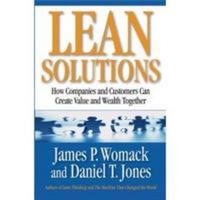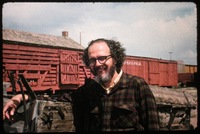Posts selected fromManagement Blog - Engineering Blog - Investing Blog and other blogs - Interview with Jim Womack (2005)

The whole idea of lean solutions is to start with today’s customer in today’s circumstances and ask what the customer really wants. When we do this, the first thing to note is that manufactured goods have gotten vastly better, somewhat cheaper
...
But we have also noticed for years the growing gap between the factory, where things are getting better, and the situation of providers and consumers where it often appears that things are getting worse.
continue reading: Interview with Jim Womack (2005) - Lean Information Technology
It is very easy for waste to be hidden in IT. I think it is more difficult to notice the inefficiencies in IT because much of the work is done in virtual space, not real space. I think that can make it more difficult to see the waste.
...
Instead of taking the time to design these properly something is created quickly, for today. If the code had a physical existence I think much of it would look like a rube Goldberg contraption. continue reading: Lean Information Technology - Appreciation for Bill Hunter
 I frequently receive kind words from people who knew my father. A recent note:
I just thought I’d let you know how much I enjoyed your dad’s class as a grad student in 1979 at UW-Madison. I’m sure you’ve heard many comments like this, but I’ll add one more. He was a delightful and entertaining prof who clearly loved his subject. He made an impression on me one day by asking us a question about the British comedy radio program, The Goon Show, which I had heard. I think I was the only member of the class who raised his hand. After that moment, I always felt a special bond with him, because I thought it was great that he appreciated the wacky humor of that show.
I received a wonderful education at UW and your dad was no small part of it.
continue reading: Appreciation for Bill Hunter - Manufacturing and the Economy (2005)
The conventional wisdom was that the rest of the world would not be able to compete with the United States for high wage, high value jobs. It turns out the rest of the world is much more able to compete for that work than was expected.
...
I think we often talk as though manufacturing in the United States is not feasible. Yes, things are changing, and have been for several decades. But the United States is still the largest manufacturer in the world.
It is true (in my belief – and based on the statistics above and in the graphs) that the United States has been decreasing manufacturing employment. And it is also true other countries – notably: China, Korea and Mexico are increasing manufacturing output. However, I believe the there has been no increase (in fact I believe their has been a decrease) in manufacturing jobs worldwide.
[in future posts I was able to find data that showed in fact China, while manufacturing output was booming, actually lost more manufacturing jobs than the USA did: Manufacturing Employment Data: USA, Japan, Germany, UK… 1990-2009, Manufacturing Job Losses: USA 2 million, China 15 million from 1995-2002, Global Manufacturing Employment Data – 1979 to 2007, Manufacturing Jobs Data: USA and China, ] continue reading: Manufacturing and the Economy (2005) - Management Training Program
So I said to the Toyota executive, “You’ve only got two or three suppliers per category, and you never take bids. How do you know you aren’t being ripped off?” So this guy, who was around 60, gives me an incredibly frosty look and says, “Because I know everything.” Everything? “That’s my job,” he says.
Reading “Because I know everything” brings to mind an arrogant blowhard to many in America (I think). Probably because most who would say that, are arrogant blowhards. But when someone has worked (a Toyota executive or a baker) for 40+ years in the same area those words can have quite a different meaning than a 31 year old MBA working in his third industry. Managing with constancy of purpose and long term thinking can make a big difference. continue reading: Management Training Program - New Business Ideas Take Time
- Going Beyond (or away from) Lean Thinking?
“Lean,” as it is commonly implemented, is not enough.
I believe ideas from Deming that are missing from many lean efforts would be helpful (Toyota applies Deming’s ideas to a much greater extent than those modifying Toyota’s practices for their organization).
Mainly what is needed is for organizaitons to more deeply impliment lean thinking. There is not a need to "go beyond" lean - the problem is poor implimentation not good implimentation of a management philosophy that has been overtaken by some new management ideas that were missing. continue reading: Going Beyond (or away from) Lean Thinking? - Deming’s Ideas at Markey’s Audio Visual
Mark Miller, General Manager, Markey’s Audio Visual spoke on Markey’s experience adopting Deming’s ideas.
- Markey’s needs to anticipate the changing needs of customers and anticipate those needs
- Unknown and unknowable – not really unknown just un-measurable (again taught to all employees)
- Gemba – where the real work gets done (the customer interaction – he stressed time and again that the key to their success was Markey’s employees interaction with customers – Markey’s aims to provide the best customer experience the customer has with any company)
- Break down barriers between departments – Markeys doesn’t charge internally. Indianapolis looses money – they own the high end equipment used by the other offices.
- Intrinsic motivation v. Extrinsic motivation – he has the chart from page 122 of New Economics in Deming’s handwriting on his wall.
continue reading: Deming’s Ideas at Markey’s Audio Visual - Why Fix the Escalator?
I think we all (including me) have to be careful when we make judgments of those we respect or find wanting. It seems our judgments often have more to do with our opinion of the person or company, than the specific behavior we believe we are judging. At times this is wise, I believe, but you should remember the basis for your opinion. continue reading: Why Fix the Escalator? - Marketing in a Lean Company
- Eliminating Complexity from Work
as much as half of the activities of about sixty people had been to set up and take down jobs, expedite, move material, count material, and do other tasks that were unnecessary in the new process.
Tim Fuller's article discusses how much inneficiency was removed from the process by adopting single piece flow in 1985. How long did it take for management practice to understand this? Certainly this understanding wasn't widespred in 2005. I am not even sure it if it is widely understood and systems have been designed or redesigned with this knowledge in 2017. continue reading: Eliminating Complexity from Work - Six Keys to Building New Markets by Unleashing Disruptive Innovation
Unfortunately we do not often stop to examine the theory and therefore fail to learn as we should as we experiment and get new results. The most effective way I know of to improve the learning is to use the PDSA cycle, predict the effects of change and then examining the results of change. As simple as those two acts are, they are skipped far to frequently.
His second point, that managers frequently use overly simplistic models or theories is also important. Management is not well suited for simple theories that can be applied in any situation. Many interdependent variables are often at play and management requires not application of simple rules but applying knowledge in complex situations as best you can. Management is challenging and simple answers are often of little value – even though they are desired. continue reading: Six Keys to Building New Markets by Unleashing Disruptive Innovation - Toyota Engineers a New Plant: the Living Kind
Toyota’s vision:
First, making things that benefit both people and the world as a whole.
…
Second, as a member of society, we must fulfill our responsibilities to all stakeholders. We must provide to customers cleaner, safer, and more attractive products with excellent value. To shareholders, we must enhance share value through long-term and stable growth by increasing profits and paying appropriate dividends. With business partners, we must engage in fair business based on a spirit of mutual benefit.
To our employees, we must provide a workplace where they can work with pride based on mutual trust and responsibility between labor and management, and respect for people.
continue reading: Toyota Engineers a New Plant: the Living Kind - There is Much to Improve in How We Use the Internet to Serve Customers
Webinars can have great interaction. They can provide very useful archived webinars covering some content (live webinars could be provided for free too if the reward was worth the cost) . If the public finds that free content valuable it can be about the most effective marketing in many ways including for gaining customers for live interactive webinars on more advanced topics.
Webinars also allow the presenter to do multiple two hour sessions for different clients anywhere in the world in the same day. So you could customize your content to specific client needs. Also each of those sessions could include employees from multiple sites around the globe. continue reading: There is Much to Improve in How We Use the Internet to Serve Customers - Malcolm Gladwell and Synchronicity
|